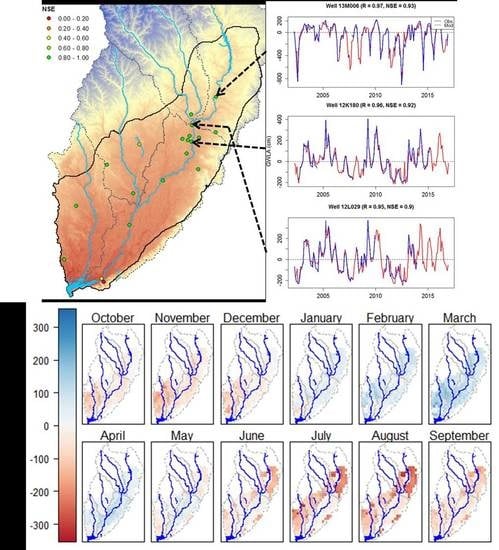Spatial Downscaling of GRACE TWSA Data to Identify Spatiotemporal Groundwater Level Trends in the Upper Floridan Aquifer, Georgia, USA
Abstract
1. Introduction
2. Materials and Methods
2.1. Study Area
2.2. Input Datasets and Pre-Processing
2.3. Downscaling Method
2.4. BRT Training
3. Results
3.1. Data Correlations
3.2. Model Performance
3.2.1. Overall Performance
3.2.2. Individual Well Performance
3.3. Map Products
3.4. Model Behavior
3.4.1. Relative Influence
3.4.2. Partial Dependence
3.4.3. Role of Soft Data in Predictions
3.5. Spatial Patterns of Groundwater Drawdown
3.5.1. Overall Patterns
3.5.2. Monthly Patterns
4. Discussion
4.1. Efficacy of the BRT Downscaling Approach
4.2. Model Insights
4.3. Potential Issues and General Applicability
5. Conclusions
Author Contributions
Funding
Acknowledgments
Conflicts of Interest
References
- UNESCO. Water Ethics and Water Resource Management; UNESCO: Bangkok, Thailand, 2011; ISBN 9789292233587. [Google Scholar]
- Wada, Y.; Van Beek, L.P.H.; Van Kempen, C.M.; Reckman, J.W.T.M.; Vasak, S.; Bierkens, M.F.P. Global depletion of groundwater resources. Geophys. Res. Lett. 2010, 37, 1–5. [Google Scholar] [CrossRef]
- Frimpong, Y.; Oluwoye, J.; Crawford, L. Causes of delay and cost overruns in construction of groundwater projects in a developing countries; Ghana as a case study. Int. J. Proj. Manag. 2003, 21, 321–326. [Google Scholar] [CrossRef]
- Mogheir, Y.; De Lima, J.L.M.P.; Singh, V.P. Assessment of informativeness of groundwater monitoring in developing regions (Gaza Strip Case Study). Water Resour. Manag. 2005, 19, 737–757. [Google Scholar] [CrossRef]
- Milewski, A.; El Kadiri, R.; Durham, M. Assessment and intercomparison of TMPA satellite precipitation products in varying climatic and topographic regimes in morocco. Remote Sens. 2015, 7, 5697–5717. [Google Scholar] [CrossRef]
- Milewski, A.; Sultan, M.; Yan, E.; Becker, R.; Abdeldayem, A.W.; Gelil, K.A. Remote sensing solutions for estimating runoff and recharge in arid environments. J. Hydrol. 2009, 373, 1–14. [Google Scholar] [CrossRef]
- Bierkens, M.F.P. Global hydrology 2015: State, trends, and directions. Water Resour. Res. 2016, 51, 4923–4947. [Google Scholar] [CrossRef]
- Lettenmaier, D.P.; Alsdorf, D.; Dozier, J.; Huffman, G.J.; Pan, M.; Wood, E.F. Inroads of remote sensing into hydrologic science during the WRR era. Water Resour. Res. 2015, 51, 7309–7342. [Google Scholar] [CrossRef]
- Tapley, B.D.; Bettadpur, S.; Watkins, M. The gravity recovery and climate experiment: Mission overview and early results. Geophys. Res. Lett. 2004, 31. [Google Scholar] [CrossRef]
- Wahr, J.; Swenson, S.; Zlotnicki, V.; Velicogna, I. Time-variable gravity from GRACE: First results. Geophys. Res. Lett. 2004, 31, 20–23. [Google Scholar] [CrossRef]
- Yeh, P.J.F.; Swenson, S.C.; Famiglietti, J.S.; Rodell, M. Remote sensing of groundwater storage changes in Illinois using the Gravity Recovery and Climate Experiment (GRACE). Water Resour. Res. 2006, 42. [Google Scholar] [CrossRef]
- Rodell, M.; Velicogna, I.; Famiglietti, J.S. Satellite-based estimates of groundwater depletion in India. Curr. Sci. 2009, 460, 999–1003. [Google Scholar] [CrossRef] [PubMed]
- Famiglietti, J.S.; Lo, M.; Ho, S.L.; Bethune, J.; Anderson, K.J.; Syed, T.H.; Swenson, S.C.; De Linage, C.R.; Rodell, M. Satellites measure recent rates of groundwater depletion in California’s Central Valley. Geophys. Res. Lett. 2011, 38, 2–5. [Google Scholar] [CrossRef]
- Scanlon, B.R.; Faunt, C.C.; Longuevergne, L.; Reedy, R.C.; Alley, W.M.; McGuire, V.L.; McMahon, P.B. Groundwater depletion and sustainability of irrigation in the US High Plains and Central Valley. Proc. Natl. Acad. Sci. USA 2012, 109, 9320–9325. [Google Scholar] [CrossRef] [PubMed]
- Feng, W.; Zhong, M.; Lemoine, J.M.; Biancale, R.; Hsu, H.T.; Xia, J. Evaluation of groundwater depletion in North China using the Gravity Recovery and Climate Experiment (GRACE) data and ground-based measurements. Water Resour. Res. 2013, 49, 2110–2118. [Google Scholar] [CrossRef]
- Lezzaik, K.; Milewski, A. A quantitative assessment of groundwater resources in the middle east and north africa region. Hydrogeology 2018, 26, 251. [Google Scholar] [CrossRef]
- Sultan, M.; Metwally, S.; Milewski, A.; Becker, D.; Ahmed, M.; Sauck, W.; Soliman, F.; Sturchio, N.; Wagdy, A.; Becker, R.; et al. Modern recharge to fossil aquifers: Geochemical, geophysical, and modeling constraints. J. Hydrol. 2011, 403, 14–24. [Google Scholar] [CrossRef]
- Lezzaik, K.; Milewski, A.; Mullen, J. The groundwater risk index: Development and application in the Middle East and North Africa region. Sci. Total Environ. 2018, 628, 1149–1164. [Google Scholar] [CrossRef]
- Famiglietti, J.S.; Rodell, M. Environmental science. Water in the balance. Science 2013, 1300–1302. [Google Scholar] [CrossRef]
- Landerer, F.W.; Swenson, S.C. Accuracy of scaled GRACE terrestrial water storage estimates. Water Resour. Res. 2012, 48. [Google Scholar] [CrossRef]
- Swenson, S.; Wahr, J. Post-processing removal of correlated errors in GRACE data. Geophys. Res. Lett. 2006, 33, 1–4. [Google Scholar] [CrossRef]
- Fowler, H.J.; Blenkinsop, S.; Tebaldi, C. Linking climate change modelling to impacts studies: Recent advances in downscaling techniques for hydrological modelling. Int. J. Climatol. 2007, 4, 1547–1555. [Google Scholar] [CrossRef]
- Lo, M.H.; Famiglietti, J.S.; Yeh, P.J.F.; Syed, T.H. Improving parameter estimation and water table depth simulation in a land surface model using GRACE water storage and estimated base flow data. Water Resour. Res. 2010, 46, 1–15. [Google Scholar] [CrossRef]
- Sun, A.Y.; Green, R.; Swenson, S.; Rodell, M. Toward calibration of regional groundwater models using GRACE data. J. Hydrol. 2012, 422, 1–9. [Google Scholar] [CrossRef]
- Houborg, R.; Rodell, M.; Li, B.; Reichle, R.; Zaitchik, B.F. Drought indicators based on model-assimilated Gravity Recovery and Climate Experiment (GRACE) terrestrial water storage observations. Water Resour. Res. 2012, 48. [Google Scholar] [CrossRef]
- Sun, A.Y. Predicting groundwater level changes using GRACE data. Water Resour. Res. 2013, 49, 5900–5912. [Google Scholar] [CrossRef]
- Haykin, S. Neural Networks and Learning Machines, 3rd ed.; Prentice Hall: Lawrence, KS, USA, 2009. [Google Scholar]
- Seyoum, W.M.; Milewski, A.M. Improved methods for estimating local terrestrial water dynamics from GRACE in the Northern High Plains. Adv. Water Resour. 2017, 110, 279–290. [Google Scholar] [CrossRef]
- Gemitzi, A.; Lakshmi, V. Estimating groundwater abstractions at the aquifer scale using GRACE observations. Geosciences 2018, 8, 419. [Google Scholar] [CrossRef]
- Miro, M.E.; Famiglietti, J.S. Downscaling GRACE remote sensing datasets to high-resolution groundwater storage change maps of California’s Central Valley. Remote Sens. 2018, 10, 143. [Google Scholar] [CrossRef]
- Seyoum, W.M.; Kwon, D.; Milewski, A.M. Downscaling GRACE TWSA data into high-resolution groundwater level anomaly using machine learning-based models in the glacial aquifer system. Remote Sens. 2019, 11, 824. [Google Scholar] [CrossRef]
- Jacob, T.; Bayer, R.; Chery, J.; Le Moigne, N. Time-lapse microgravity surveys reveal water storage heterogeneity of a karst aquifer. J. Geophys. Res. Solid Earth 2010, 115, 1–18. [Google Scholar] [CrossRef]
- Couch, C.A.; McDowell, R.J. Flint River Basin Regional Water Development and Conservation Plan; Georgia Department of Natural Resources-Environmental Protection Division: Atlanta, GA, USA, 2006. [Google Scholar]
- Torak, L.J.; Painter, J. Geohydrology of the Lower Apalachicola–Chattahoochee–Flint River Basin, Southwestern Georgia, Northwestern Florida and Southeastern Alabama; USGS: Reston, VA, USA, 2006.
- Torak, L.J.; McDowell, R.J. Ground-Water Resources of the Lower Apalachicola-Chattahoochee-Flint River Basin in Parts of Alabama, Florida, and Georgia—Subarea 4 of the Apalachicola-Chattahoochee-Flint and Alabama-Coosa-Tallapoosa River Basins; National Park Service: Washington, DC, USA, 1996. [Google Scholar]
- Hicks, D.W.; Gill, H.E.; Longsworth, S.A. Hydrogeology, Chemical Quality, and Availability of Ground Water in the Upper Floridan Aquifer, Albany Area, Georgia; Water-Resources Investigations Report 87–4145; U.S. Geological Survey: Doraville, GA, USA, 1987; 31p.
- Torak, L.J. A MODular Finite-Element model (MODFE) for areal and axisymmetric ground-water-flow problems, part 1: Model description and user’s manual. In Techniques of Water-Resources Investigations; Book 6; US Geological Survey: Reston, VA, USA, 1993. [Google Scholar]
- Rugel, K.; Golladay, S.W.; Jackson, C.R.; Rasmussen, T.C. Delineating groundwater/surface water interaction in a karst watershed: Lower Flint River Basin, southwestern Georgia, USA. J. Hydrol. Reg. Stud. 2016, 5, 1–19. [Google Scholar] [CrossRef]
- Rugel, K.; Jackson, C.R.; Romeis, J.J.; Golladay, S.W.; Hicks, D.W.; Dowd, J.F. Effects of irrigation withdrawals on streamflows in a karst environment: Lower Flint River Basin, Georgia, USA. Hydrol. Process. 2012, 26, 523–534. [Google Scholar] [CrossRef]
- Kuniansky, E.L.; Bellino, J.C.; Dixon, J.F. Transmissivity of the Upper Floridan Aquifer in Florida and Parts of Georgia, South Carolina, and Alabama; US Geological Survey: Reston, VA, USA, 2012.
- Friedman, J.H. Greedy function approximation: A gradient boosting machine. Ann. Stat. 2001, 29, 1189–1232. [Google Scholar] [CrossRef]
- Elith, J.; Leathwick, J.R.; Hastie, T. A working guide to boosted regression trees. J. Anim. Ecol. 2008, 77, 802–813. [Google Scholar] [CrossRef] [PubMed]
- Breiman, L. Statistical modeling: The two cultures. Stat. Sci. 2001, 16, 199–231. [Google Scholar] [CrossRef]
- De’ath, G.; Fabricius, K.E. Classification and regression trees: A powerful yet simple technique for ecological data analysis. Ecology 2000, 81, 3178–3192. [Google Scholar] [CrossRef]
- Leathwick, J.R.; Elith, J.; Francis, M.P.; Hastie, T.; Taylor, P. Variation in demersal fish species richness in the oceans surrounding New Zealand: An analysis using boosted regression trees. Mar. Ecol. Prog. Ser. 2006, 321, 267–281. [Google Scholar] [CrossRef]
- Lemercier, B.; Lacoste, M.; Loum, M.; Walter, C. Extrapolation at regional scale of local soil knowledge using boosted classification trees: A two-step approach. Geoderma 2012, 171, 75–84. [Google Scholar] [CrossRef]
- Jorda, H.; Bechtold, M.; Jarvis, N.; Koestel, J. Using boosted regression trees to explore key factors controlling saturated and near-saturated hydraulic conductivity. Eur. J. Soil Sci. 2015, 66, 744–756. [Google Scholar] [CrossRef]
- Naghibi, S.A.; Pourghasemi, H.R. A comparative assessment between three machine learning models and their performance comparison by bivariate and multivariate statistical methods in groundwater potential mapping. Water Resour. Manag. 2015, 29, 5217–5236. [Google Scholar] [CrossRef]
- Lee, S.; Lee, C.-W.; Lee, S.; Lee, C.-W. Application of decision-tree model to groundwater productivity-potential mapping. Sustainability 2015, 7, 13416–13432. [Google Scholar] [CrossRef]
- Nolan, B.T.; Fienen, M.N.; Lorenz, D.L. A statistical learning framework for groundwater nitrate models of the Central Valley, California, USA. J. Hydrol. 2015, 531, 902–911. [Google Scholar] [CrossRef]
- Cunningham, S.C.; Thomson, J.R.; Mac Nally, R.; Read, J.; Baker, P.J. Groundwater change forecasts widespread forest dieback across an extensive floodplain system. Freshw. Biol. 2011, 56, 1494–1508. [Google Scholar] [CrossRef]
- Naghibi, S.A.; Pourghasemi, H.R.; Dixon, B. GIS-based groundwater potential mapping using boosted regression tree, classification and regression tree, and random forest machine learning models in Iran. Environ. Monit. Assess. 2016, 188, 1–27. [Google Scholar] [CrossRef]
- Schapire, R.E. The Boosting Approach to Machine Learning: An Overview; Springer: Berlin, Germany, 2003; pp. 149–171. [Google Scholar]
- Breiman, L. Arcing classifiers. Ann. Stat. 1998, 26, 801–849. [Google Scholar]
- Greenwell, B.; Boehmke, B.; Cunningham, J.; Developers, G. Gbm: Generalized Boosted Regression Models 2019. Available online: http://www.i-pensieri.com/gregr/gbm.shtml (accessed on 15 April 2006).
- Hijmans, R.J.; Phillips, S.; Leathwick, J.; Elith, J. Dismo: Species Distribution Modeling. Available online: http://cran.r-project.org/web/packages/dismo/index.html (accessed on 9 January 2017).
- R Core Team. R: A Language and Environment for Statistical Computing; R Foundation for Statistical Computing: Vienna, Austria, 2018; Available online: https://www.R-project.org/ (accessed on 17 August 2018).
- Moriasi, D.N.; Arnold, J.G.; Van Liew, M.W.; Bingner, R.L.; Harmel, R.D.; Veith, T.L. Model evaluation guidelines for systematic quantification of accuracy in watershed simulations. Trans. ASABE 2007, 50, 885–900. [Google Scholar] [CrossRef]
- Friedman, J.H.; Meulman, J.J. Multiple additive regression trees with application in epidemiology. Stat. Med. 2003, 22, 1365–1381. [Google Scholar] [CrossRef]
- Arnold, J.G.; Youssef, M.A.; Yen, H.; White, M.J.; Sheshukov, A.Y.; Sadeghi, A.M.; Moriasi, D.N.; Steiner, J.L.; Amatya, D.M.; Skaggs, R.W.; et al. Hydrological processes and model representation: Impact of soft data on calibration. Trans. ASABE 2015, 58, 1637–1660. [Google Scholar]
- Wait, R.L. Geology and Ground-Water Resources of Dougherty County: Geological Survey Water-Supply Paper 1539-P; US Geological Survey: Reston, VA, USA, 1963.
- Coppola, E.; Poulton, M.; Charles, E.; Dustman, J.; Szidarovszky, F. Application of Artificial Neural Networks to Complex Groundwater Management Problems; Springer: Berlin, Germany, 2003; Volume 12. [Google Scholar]
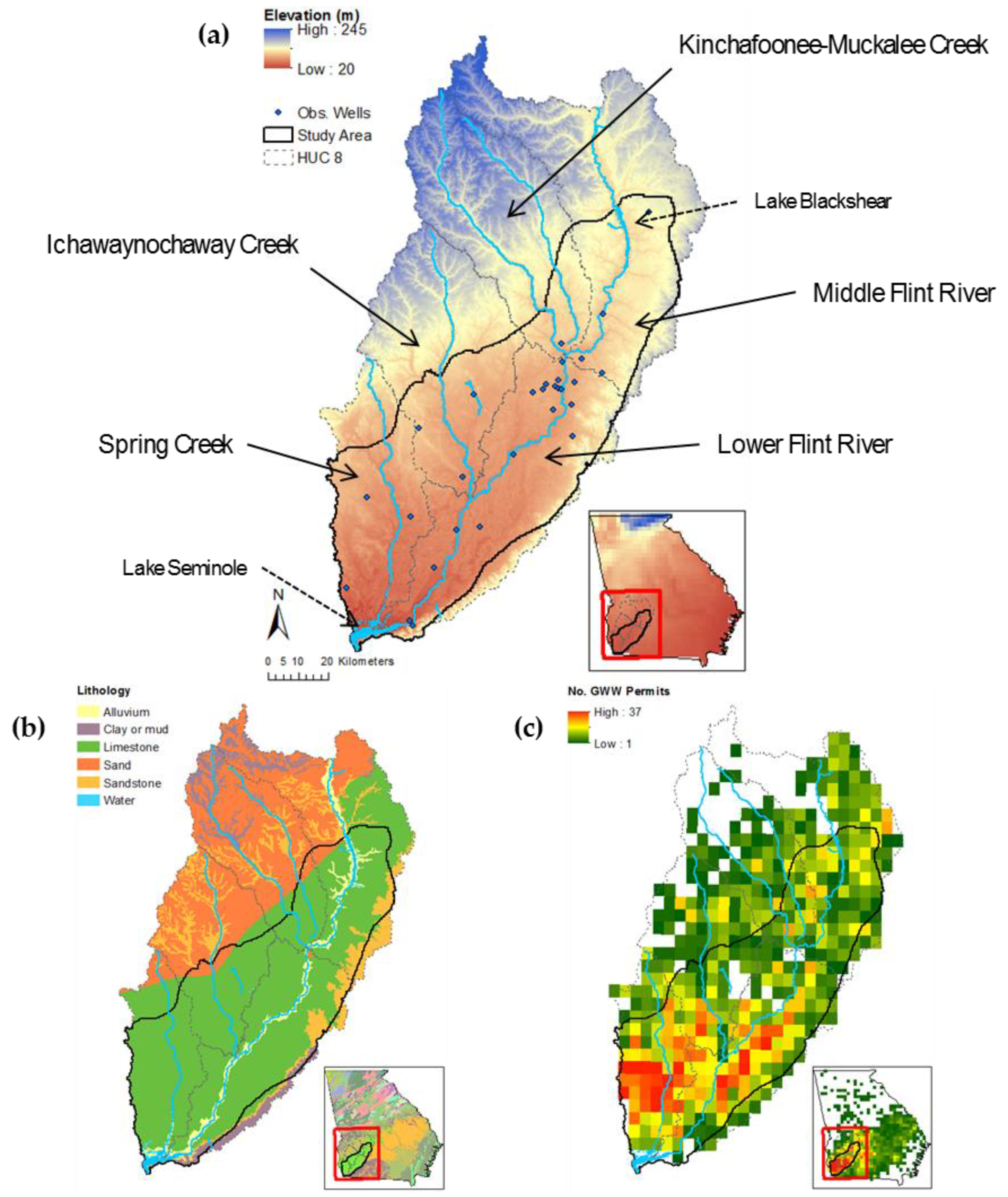
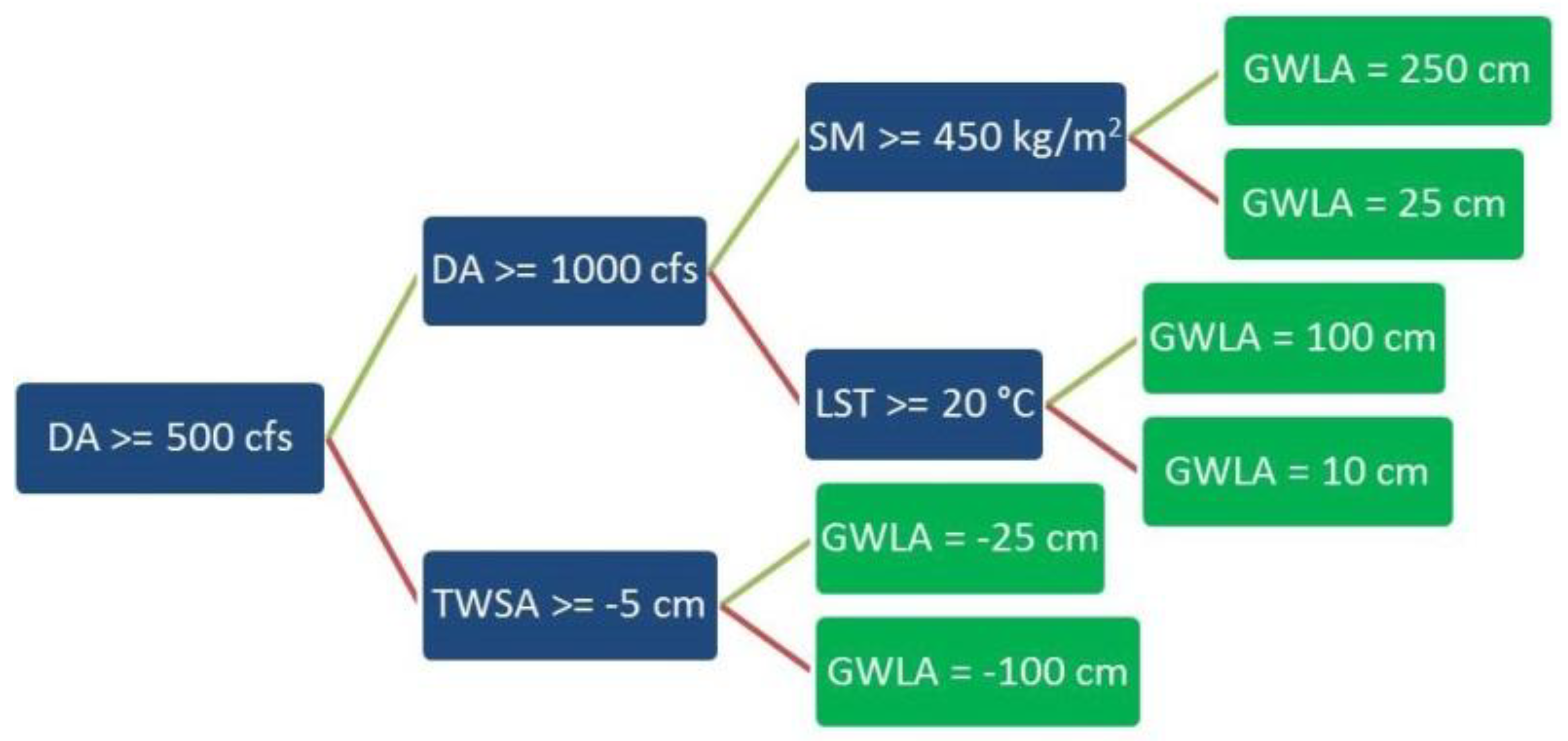
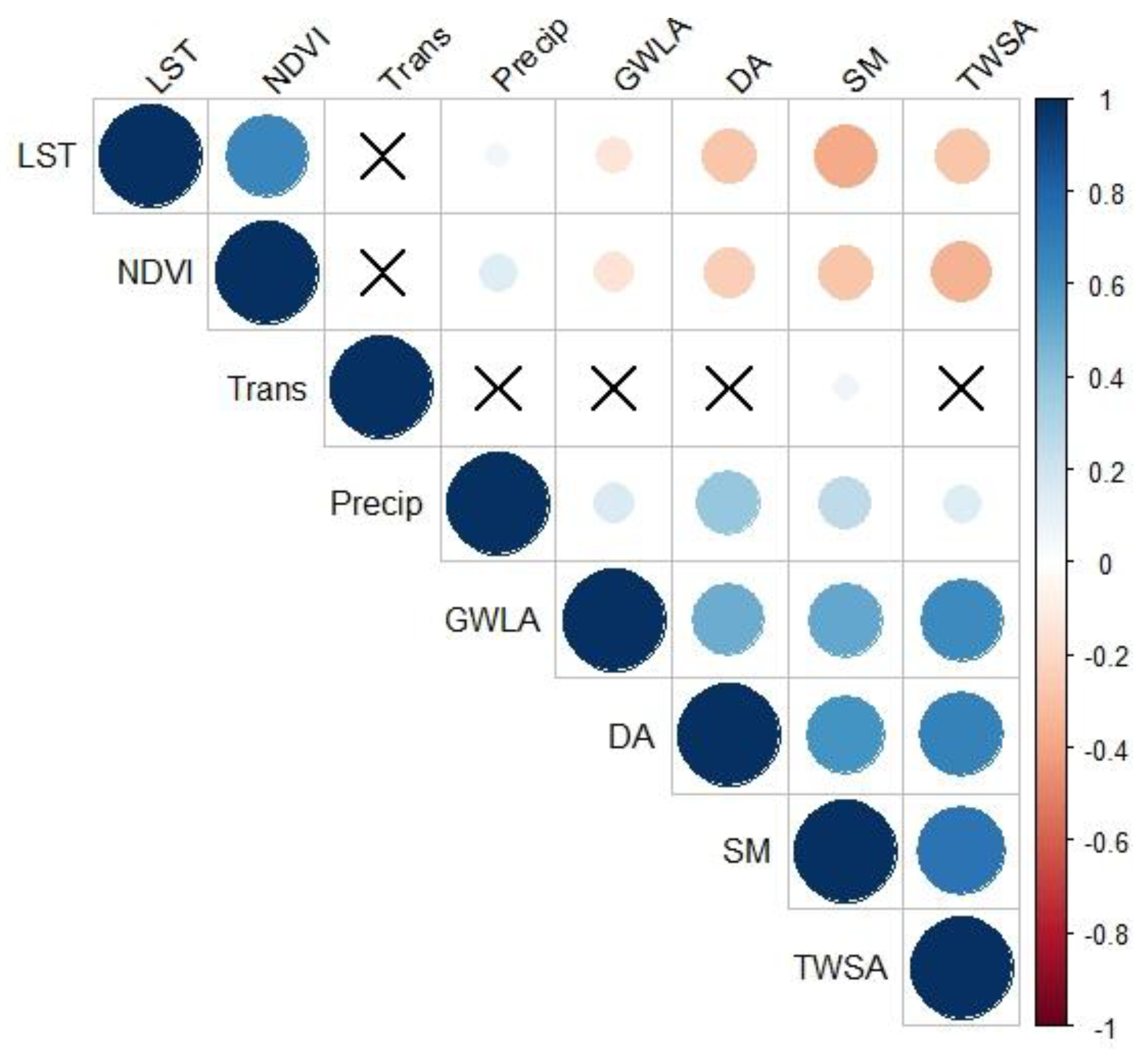
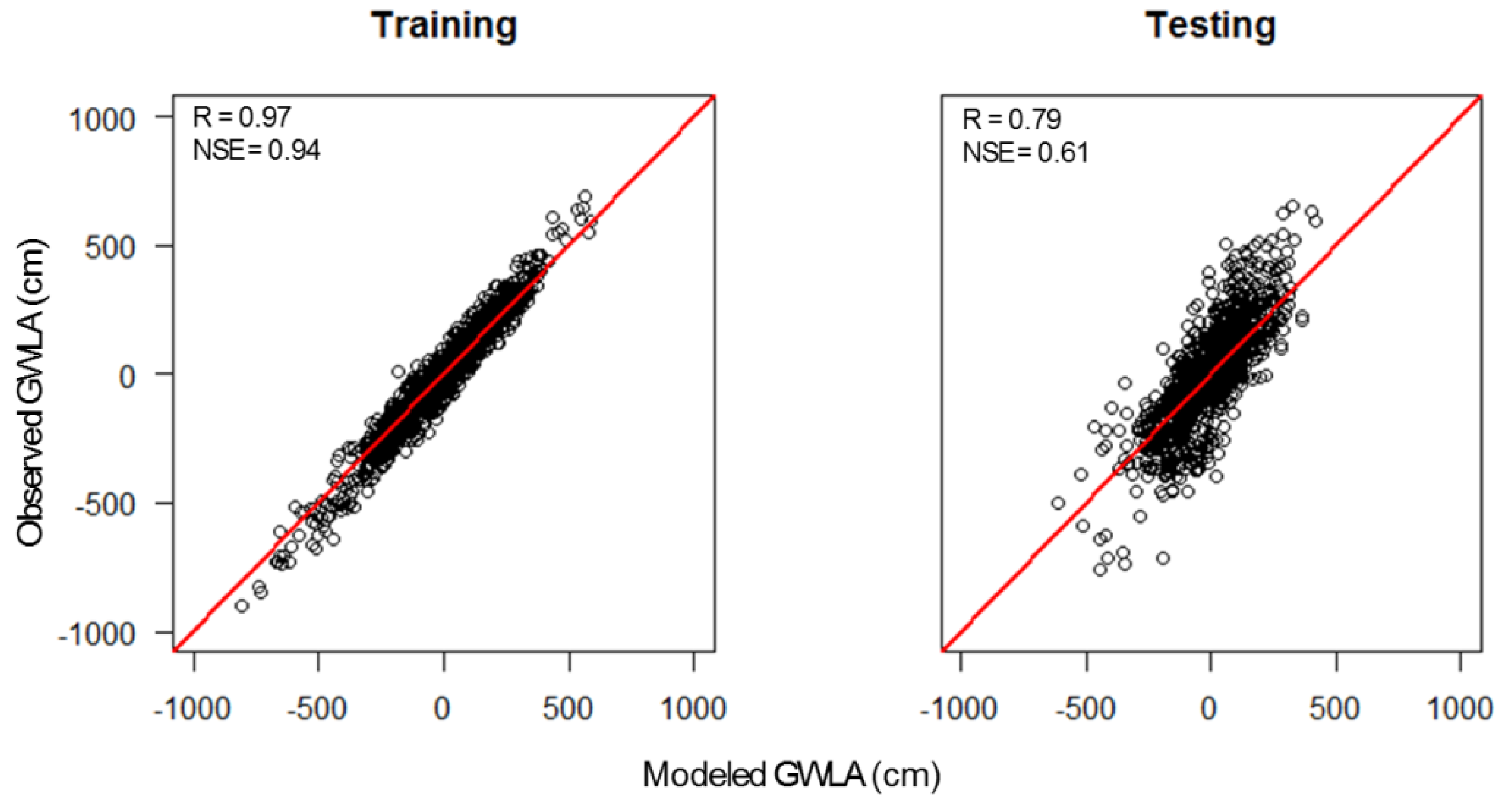
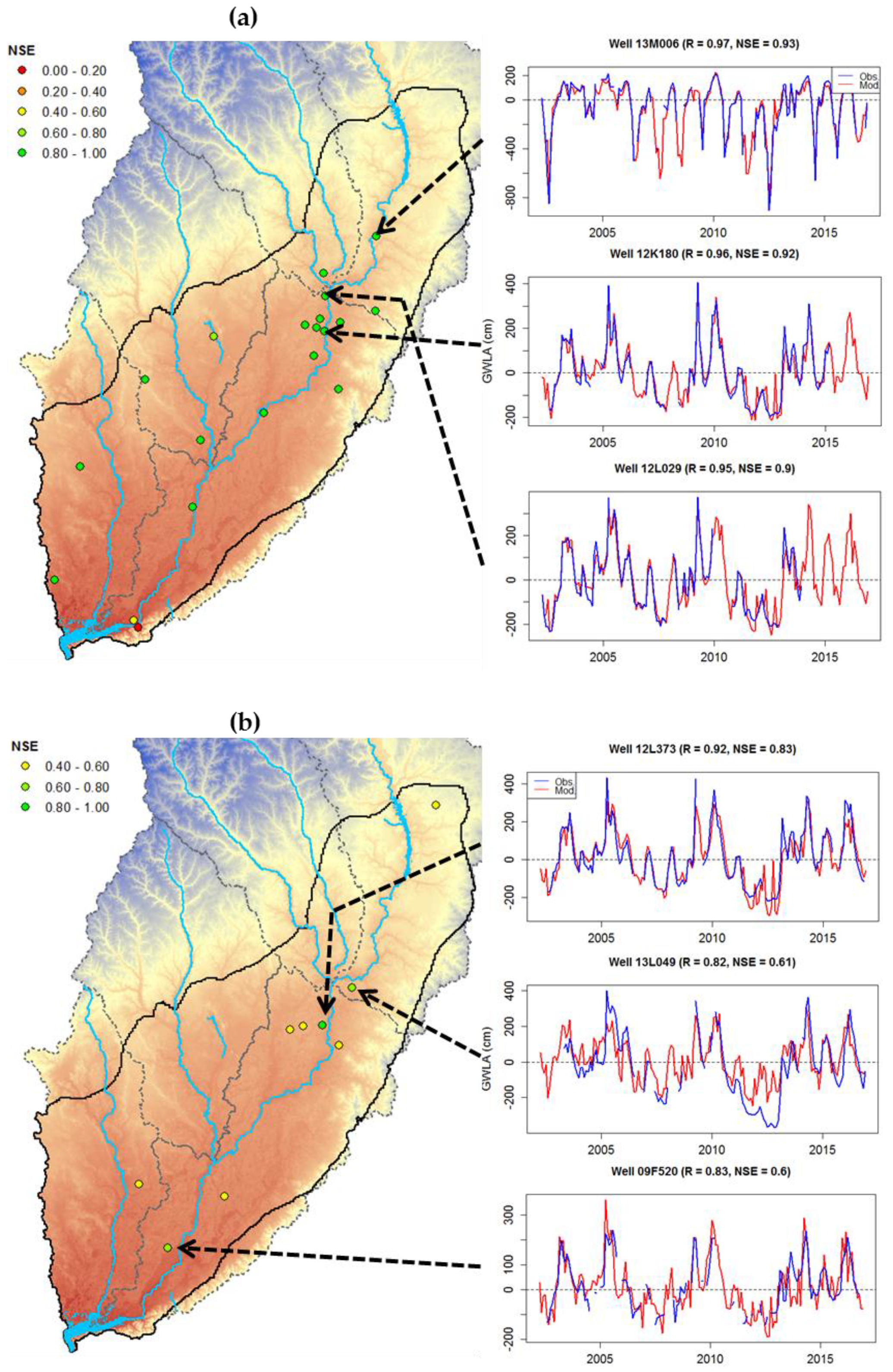
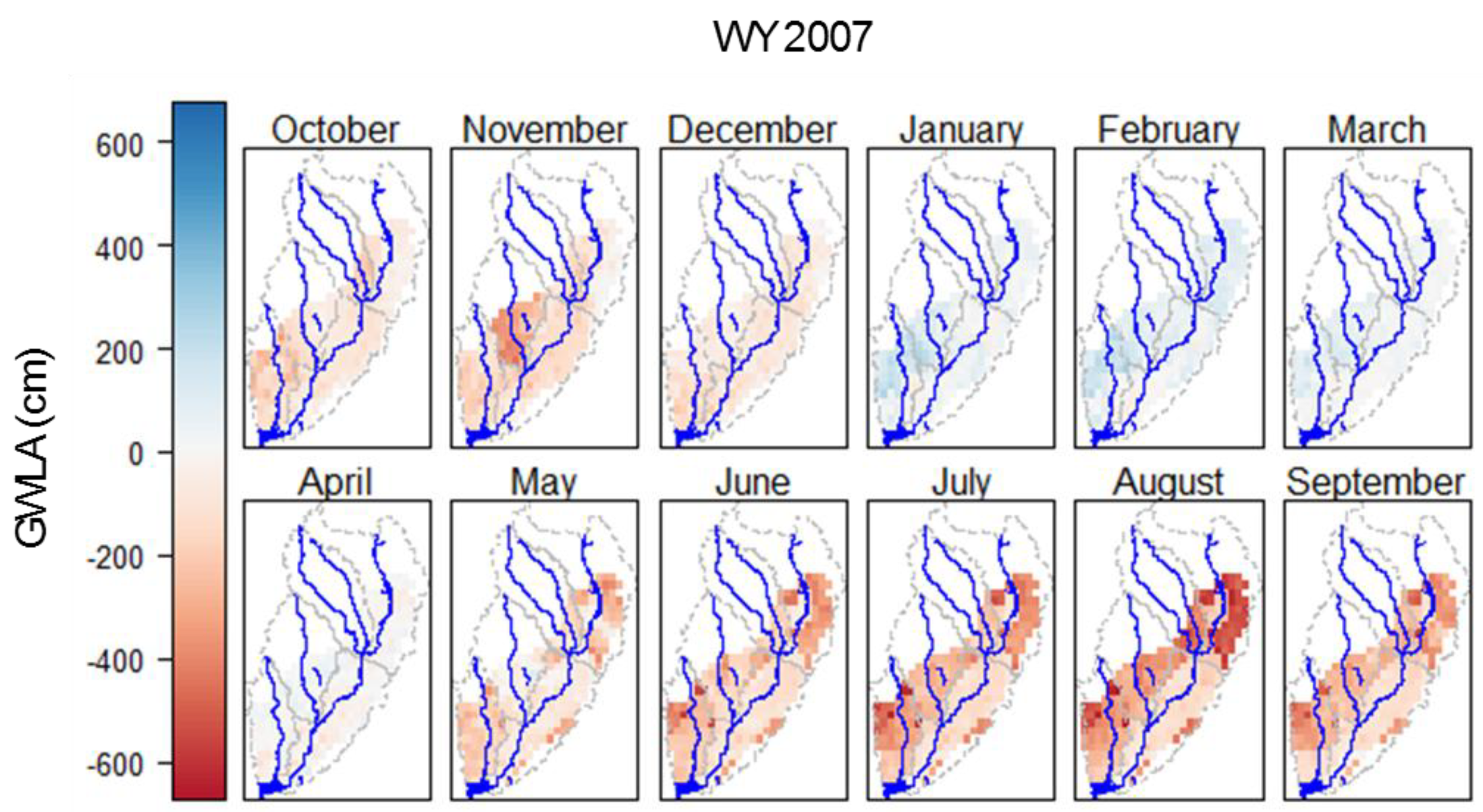
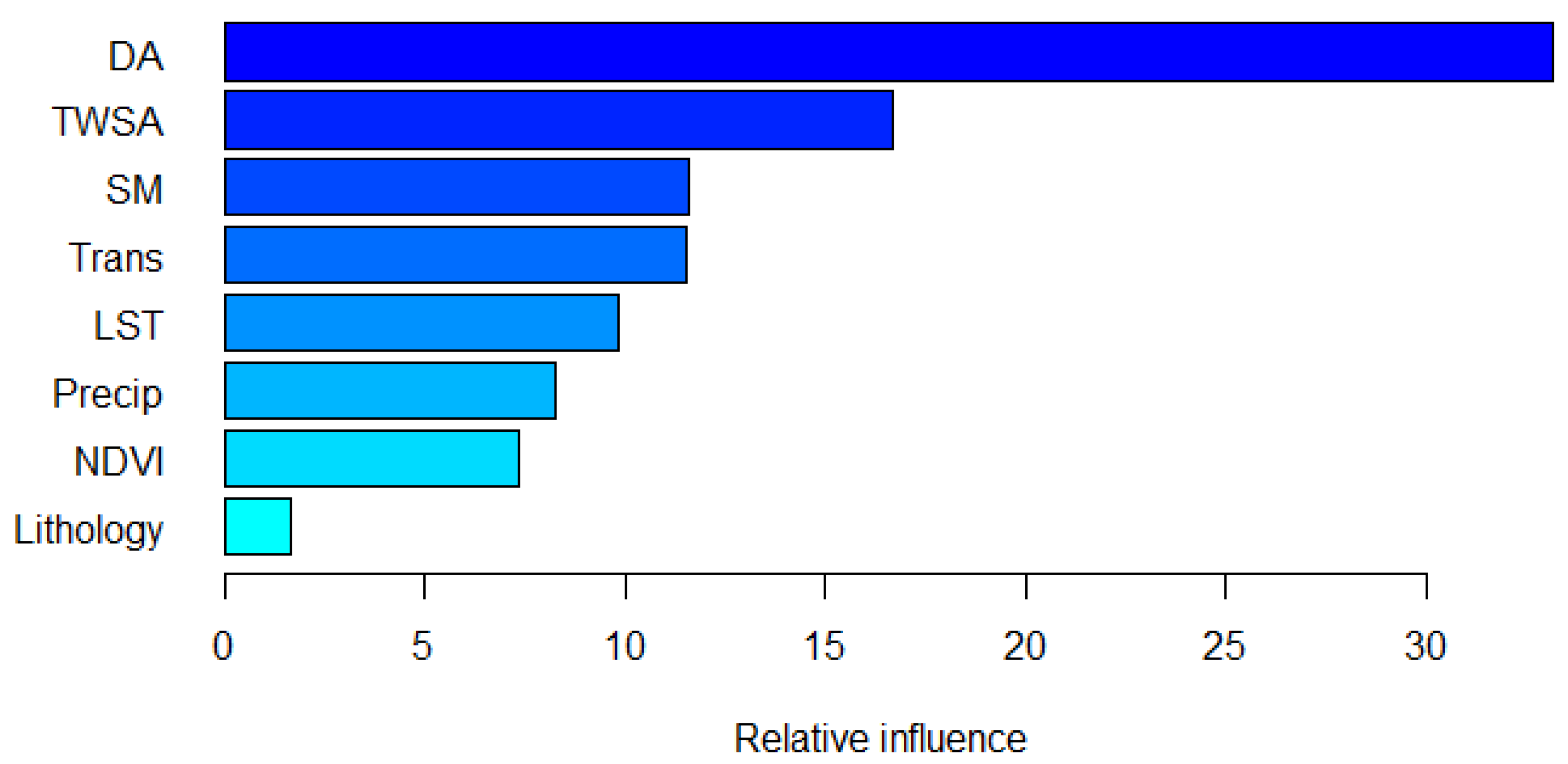



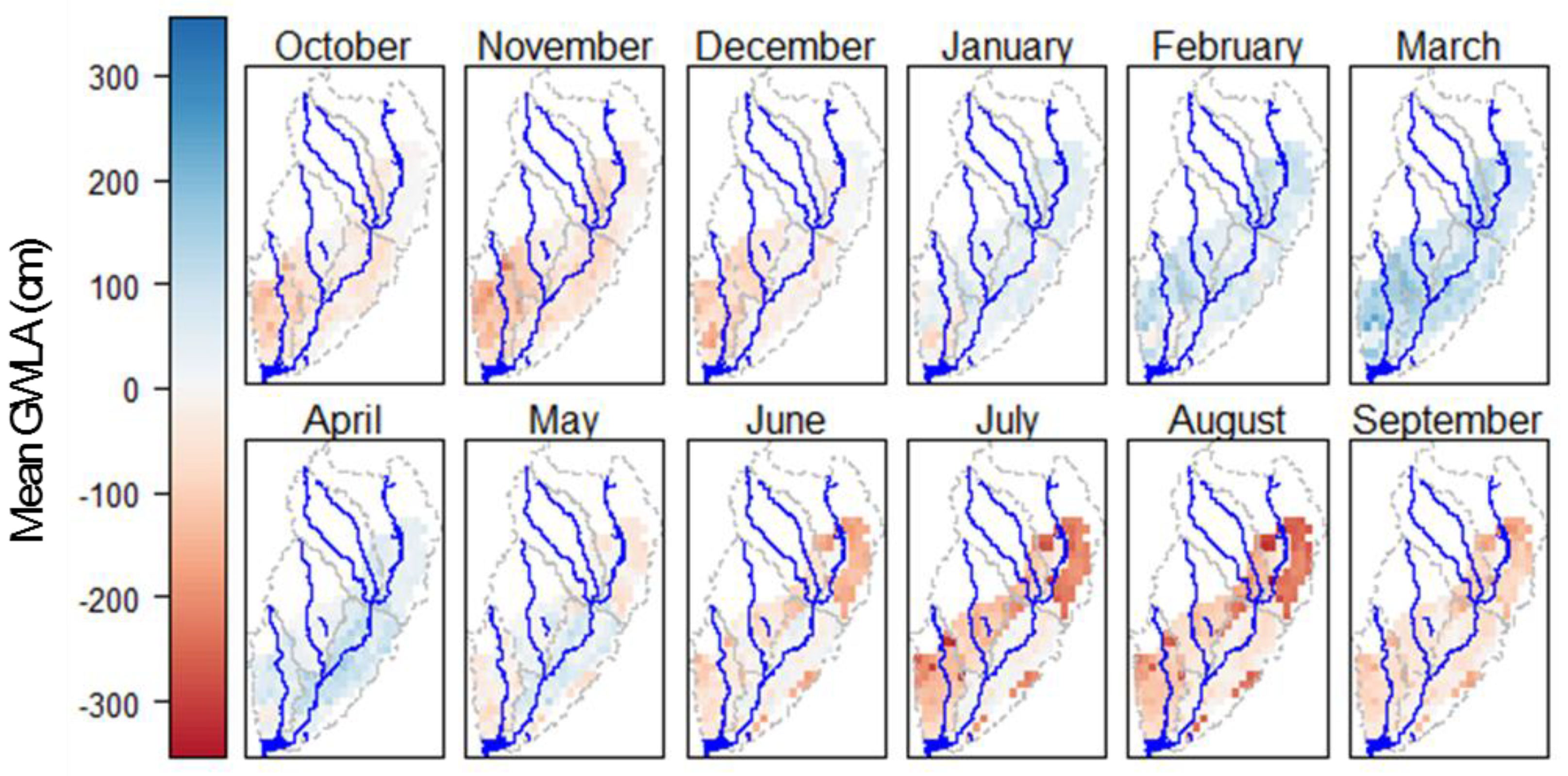
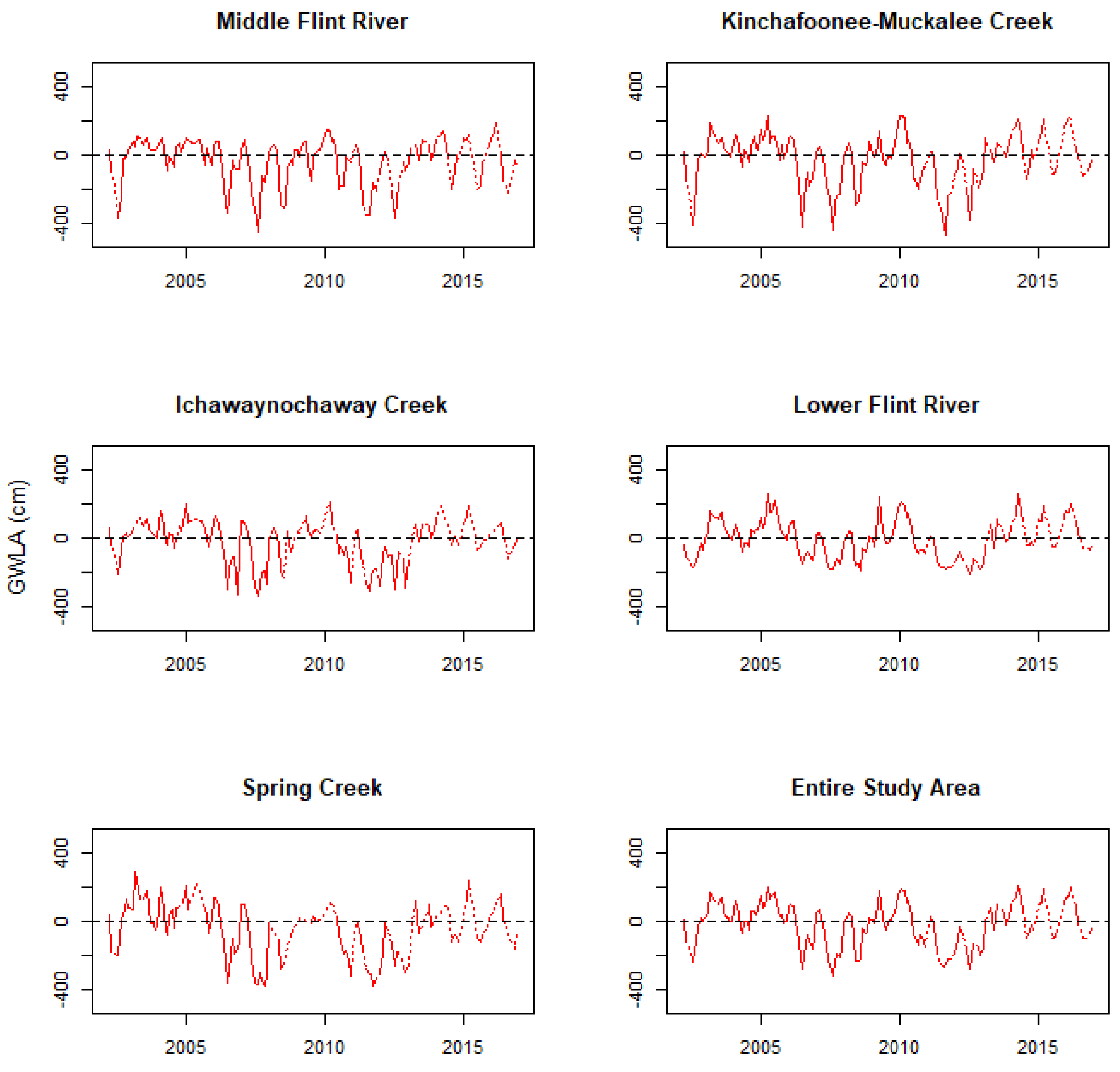
| Dataset | Source | Data Type | Units | Spatial Resolution | Temporal Resolution | Processing |
|---|---|---|---|---|---|---|
| Precipitation | PRISM | Modeled | mm | 4 km | Monthly | Resampled to target resolution |
| LST | MODIS | Remote Sensing | °C | 0.05° | Monthly | N/A |
| NDVI | MODIS | Remote Sensing | N/A | 0.011° | Monthly | Resampled to target resolution |
| Soil Moisture | Noah LSM | Modeled | kg/m2 | 0.125° | Monthly | Disaggregated to target resolution |
| Discharge Anomaly | USGS | In Situ | ft3/s | HUC 8 | Monthly | Anomaly calculated relative to 2004–2009 mean |
| Lithology | GA EPD | In Situ | N/A | N/A | N/A | Rasterized to target resolution |
| Transmissivity | USGS | In Situ | log10(ft2/d) | Point | N/A | Kriged to target resolution, log transformed |
| TWSA | GFZ, JPL, CSR | Remote Sensing | cm | 1° | Monthly | Disaggregated to target resolution |
| GWLA | USGS | In Situ | cm | Point | Monthly | Anomaly calculated relative to 2004–2009 mean |
© 2019 by the authors. Licensee MDPI, Basel, Switzerland. This article is an open access article distributed under the terms and conditions of the Creative Commons Attribution (CC BY) license (http://creativecommons.org/licenses/by/4.0/).
Share and Cite
Milewski, A.M.; Thomas, M.B.; Seyoum, W.M.; Rasmussen, T.C. Spatial Downscaling of GRACE TWSA Data to Identify Spatiotemporal Groundwater Level Trends in the Upper Floridan Aquifer, Georgia, USA. Remote Sens. 2019, 11, 2756. https://doi.org/10.3390/rs11232756
Milewski AM, Thomas MB, Seyoum WM, Rasmussen TC. Spatial Downscaling of GRACE TWSA Data to Identify Spatiotemporal Groundwater Level Trends in the Upper Floridan Aquifer, Georgia, USA. Remote Sensing. 2019; 11(23):2756. https://doi.org/10.3390/rs11232756
Chicago/Turabian StyleMilewski, Adam M., Matthew B. Thomas, Wondwosen M. Seyoum, and Todd C. Rasmussen. 2019. "Spatial Downscaling of GRACE TWSA Data to Identify Spatiotemporal Groundwater Level Trends in the Upper Floridan Aquifer, Georgia, USA" Remote Sensing 11, no. 23: 2756. https://doi.org/10.3390/rs11232756
APA StyleMilewski, A. M., Thomas, M. B., Seyoum, W. M., & Rasmussen, T. C. (2019). Spatial Downscaling of GRACE TWSA Data to Identify Spatiotemporal Groundwater Level Trends in the Upper Floridan Aquifer, Georgia, USA. Remote Sensing, 11(23), 2756. https://doi.org/10.3390/rs11232756





